An essential component of our milking system broke!
A peachy breakfast
Blackberries ripening
Happenings on the farm, news, and food for thought!



An essential component of our milking system broke!






A peachy breakfast


Blackberries ripening


It’s no secret that we are all feeling the price crunch in the checkout line.
The food inflation rate is debatable, but we can safely say food prices have gone up substantially in the last four years.
It’s tempting to buy groceries at the cheapest location, but is there a greater untold cost to that decision?
Groceries used to come from backyard gardens, neighbors, and local small farms. Until recent years, it simply wasn’t possible to get substantial amounts of food imported elsewhere.
Now, we have the infrastructure to import foods from all over the world…the ability to buy broccoli at the drop of a hat or raspberries in January.
This is a terrific convenience, but it also has a cost.
Local farms are being pushed out of the market (or bought out) by their bigger competitors, and we aren’t, by and large, eating foods that are grown local to us.
So why exactly should we prioritize local food when it isn’t as convenient as going to the grocery store and is often more expensive than comparable grocery store items?
Local food has a unique nutrient profile
Food grown in your area has unique nutrients and information that you need. Specific beneficial bacteria, pollen information, and information from sunlight in stored in the food.
Food grown at your latitude will have the correct information for your body. This is one reason why local raw milk and raw honey can be so beneficial for treating allergies. It has the information your body needs to heal itself.
2. Food is most nutritious right at picking time
Food is most nutritious when it’s picked at its naturally ripened time. After picking, many of the nutrients, like vitamin C, degrade. Strawberries, for example, lose most of their vitamin C within 48 hours of being picked.
Food that is being shipped in from South America or California simply can’t compete with food grown in your backyard or nearby.
3. Big box organics (Walmart, etc.) are crowding out small farms
During a recent podcast episode of the Real Organic Food Podcast [Lisa Held ROP#181], a food researcher and journalist relayed the following information about Walmart and their Organics program.
Walmart cuts costs by under paying farmers, and small farmers can’t sell at Walmart’s prices and cover their costs, much less make a profit.
Walmart cuts costs everywhere they can, and this artificially lower prices from what the true cost of food should be.
Walmart is the biggest vendor of organic food worldwide, and 1 in 3 grocery dollars in the US are spent at Walmart. This means that they have a huge power in setting the frame for what is a fair and reasonable price.
The truth is there aren’t any small farms selling to Walmart, and shopping with big box grocery stores can actively hurt the local economy.
4. Shopping locally keeps money in your local economy
It’s been shown that dollars spent locally tend to stay in the local economy for many more transactions than do dollars spent at multinational corporations.
The best way to build resilient food systems that actually serve our health is to shop locally and get to know your farmer.

Patsy had twins! Again! Two years in a row!

The pigs (Betsey, Bertha, and Billie Jo), enjoying a mud hole in the summer heat.

Blue heron hunting in the field as we irrigate.

The milk cows like to stand and chew their cud after milking, in no rush to leave the barn area.

Bilbo, Nymph and Duchess doing well in the field with their nurse cow!

Patsy needed to go in the barn to be milked out, but was holding her milk, so we brought Calypso in to nurse while she milking to help her let down.

Lia waiting to help take Calypso back out to the calf pens.

Smoky sunrise.

Spider web in the open window of the farm truck.

The cows don't find chicory very palatable, but it sure is pretty!

A much less smoky sunrise!

Funny farming quote from Facebook.

Beef.
It’s what’s for…breakfast??
Yes.
I’ve tried several beef breakfast recipes and this one is closest to a traditional sausage flavor.
INGREDIENTS
2 lbs Saint John’s organic grass fed beef
1 tsp garlic powder
2 tsp onion powder
2 tsp smoked paprika
1 tsp paprika
1 ½ tsp dried sage
1 ½ tsp dried thyme
1 tsp sea salt
½ tsp red pepper flakes
½ tsp ground black pepper
Tallow or lard for frying, optional
METHOD
You can bake these for 20 minutes or pan fry.
Pan frying will yield a crispier, more authentic “breakfast sausage” vibe to the dish. But baking is more convenient if you don’t have time to watch a skillet.
If baking, preheat oven to 400 degrees.
Mix together beef and spices well.
Form into small, about 2 oz thin and flat patties.
If baking, lay patties in a glass baking pan or other baking pan lined with foil. If pan frying, preheat a pan over medium-high heat and melt tallow or lard.
Place patties in the oven for 20 minutes or pan fry for about 8 minutes.
Cook until patties reach an internal temperature of 165 degrees.
Serve with hash browns, eggs, and hot sauce of choice.
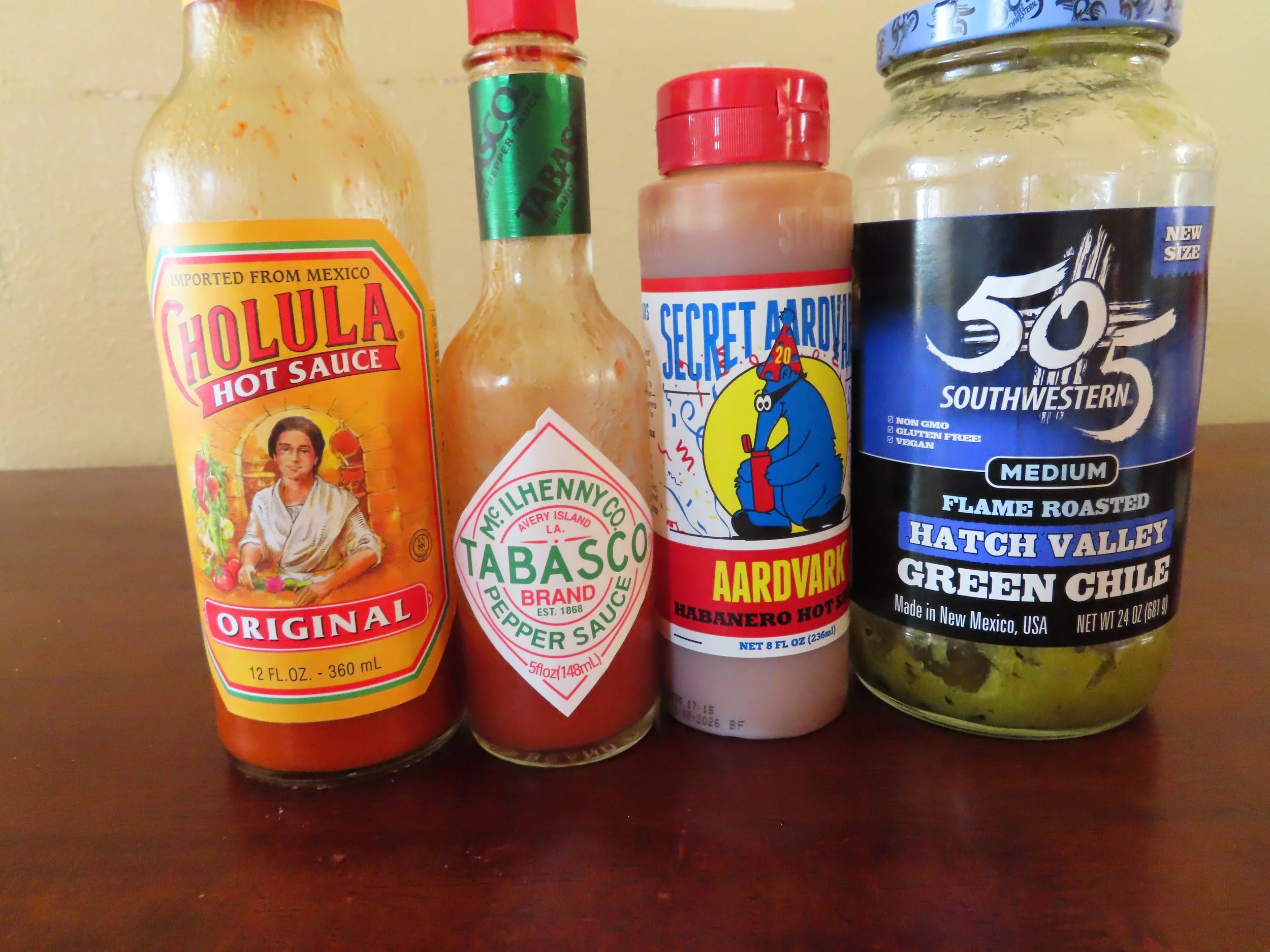
The breakfast hot sauce line-up.
by Claire Dill

Nymph

Nymph

Bilbo

Bees on the wild blackberry blossoms.

Russian Olives in bloom.

Double rainbow!

Lia enjoying the ditch on a hot day.

Summer sunrise.

Haying!


Saint John’s Brown Swiss cows grazing on fresh Spring pasture.
by Claire Dill
We have Brown Swiss cows. My grandparents had Holsteins with a few Jerseys and the odd Brahma, but when we moved, my dad, (Claire writing) wanted to transition to Brown Swiss. So we bought Napoleon, a purebred Brown Swiss bull, in 2001, and began the years long journey of changing the herd from black and white Holsteins to the Brown Swiss.
Generations later, and half a dozen purebred Brown Swiss bulls, (Major, Galileo, Sitting Bull, Monarch, Banner, Icarus, and now Maximus :) ), our herd is Swiss. Not registered, but pretty well full Swiss.
In 2017, Banner was giving us some trouble with attitude, so we sent him to the butcher and borrowed a friends' Angus bull (Pumpkin) to finish out the season. Then we decided to try another beef breed, the Red Devon, for a couple of years. My brothers named him "Red Bull". :) He was a decent bull, but his kids were wild and rangeminded and not very impressive. Even though we handled the calves the same, and the moms were the same Swiss, the red calves were really different, just from their daddy's genetics!
When we went back to having a Swiss bull, it was absolutely great, and also really interesting to see the calves again exhibiting the typical Swiss gentleness and amiability. (Funny sidenote on the curiousness of genetics, of "nature versus nurture" and how much temperament the daddy can contribute; where, with animals, the daddy doesn't raise the kids. Here, the moms didn't change, and the handling of the calves didn't change, but just simply changing the daddy from Brown Swiss to the beef bulls, gave consistently rangeminded calves. !)
We like the Brown Swiss because of their temperaments, dual ability for milk and beef, and milk quality and taste.
Their temperament as a breed is "phlegmatic", laid back, mellow, thoughtful, gentle, curious, calm, and reasonable.
There's plenty of individuality in the herd, but as a broad brush description, this is the expectable norm.
They are good mothers, but also in general happy to have people around and are good for working with the cows and calves.
Some bovine breeds are focused on beef, and some on milk production, the Swiss are quite balanced. They give lots of milk (often 7 or 8 gallons per milking at their peak), but they also put on muscle and weight well for the beef side of things.
And they are bred to thrive on pasture, and do not have to be fed grain to reach peak condition for butchering.
Their milk is one of the best in the world for cheesemaking, with a very balanced fat/protein content, and a good amount of butterfat for cream.
The American Brown Swiss is descended from the Braunvieh from Switzerland. Documents dating from the late fourteenth century at the Benedictine Monastery of Einsiedeln in the Swiss canton of Schwyz in Central Switzerland record the export of grey-brown mountain cows from medieval bloodlines to Vorarlberg, now part of Austria.
The first known herd book for a cattle breed was the one kept at the monastery for the Braunvieh from 1775 to 1782. Most dairy historians agree that Braunvieh cattle are the oldest of all dairy breeds.
Braunvieh were imported to the United States in the 1860s and while American breeders generally focus on milk production, some of the draft and beef strengths do remain.
Also, many Brown Swiss have the A2A2 genes, producing A2 beta casein protein in their milk. This is the same beta casein as human milk, and sheep and goat milk, making A2A2 milk apparently easier for many people to digest than A1A1 milk.
Dairy breeds from Northern Europe tend to have more of the A1A1 genes, and are bred for large volumes of production. This has been popular with many modern dairy farmers, but may have contributed to the high rate of dairy allergies/reactions today.

by Courtney Meyerhofer
Is grass fed butter healthy?
Butter has been demonized the last few decades, but it’s coming back into vogue as more people are adopting a whole foods, ancestral approach to nutrition.
100 years ago, Americans ate 18 pounds of butter per person per year!
Today, Americans eat about 5 pounds of butter per person per year.
People then didn’t have the chronic disease epidemic we have today, and they didn’t worry about their butter consumption.
Grass fed butter is high in trace minerals.
Iodine
Calcium
Phosphorous
Magnesium
Iron
Selenium
Modern diets are generally low in these minerals because of soil depletion AND we use more of these minerals due to our higher stress pace of life. This means we need all the minerals we can get.
2. Grass fed butter is high in fat soluble vitamins A D E and K.
Fat soluble vitamins are needed for every cell, every hormone and are linked to longevity. Vitamin E is a powerful antioxidant that helps our bodies handle inflammation and stress.
3. Anti-cancer conjugated linoleic acid (CLA) is uniquely rich in the products of grass fed ruminants.
You can find CLA in grass fed meat, grass fed dairy and butter.
4. Grass fed butter is high in butyric acid, a powerful anti-inflammatory hard to find in most foods.

Mum grooming Sunflower while Aciano nurses.
by Claire Dill



Another farm sunrise

Aciano

Foxtail against the red barn. :)

Bertha, Betsey, and Billie Jo.

Kittens :)

On a hot day, the pigs sit in their food bowl...

by Courtney Meyerhofer
One of the best things about milk is….cheese.
As the weather warms up, it’s the perfect time to make cool, creamy cheese that you can eat with anything.
Anyone with a pot, some milk, and vinegar or cultures can make their own soft cheese.
Unlike hard cheese like cheddar and gouda, soft cheese is ready straight away without any drying or aging.
Cottage cheese. Cream cheese. Fromage blanc. Mascarpone.
All of these are soft cheeses that are delicious on eggs, on pizza, with fruit, or spread on toast.
Soft cheese is simple and decidedly un-fussy. Here are some tips for success.
Don’t Skip the Warm-Up
Warming up the milk before adding cultures sets you up for cheesemaking success because a little heat makes the good bacteria thrive.
Set a timer
Cheese has to follow a timeline, and it’s different for each culture and cheese type. Make sure to plan ahead so you can strain the cheese after the specified time.
Good cheese cannot be rushed!
Get the Cultures
Cottage cheese is easily made with just milk and vinegar, but anything else requires the assistance of helpful, friendly bacteria to culture.
Tried and true Cheese Cultures:
New England Cheesemaking Company – I like the soft cheese sample pack
If you want to try homemade cheese without the cultures, try our fool-proof 2-ingredient cottage cheese recipe.
If you’re ready for local, grass fed raw A2 milk, we’ve got you covered.
Check out the details of our Raw Milk co-op.

Hoof trimming with JJ. Mark Mourton is the best trimmer, quick, careful, fun to work with and absolutely amazing with the cows. He's firm and fast and takes no nonsense, but he's also thoughtful and kind and doesn't mind when the cows are confused or grumpy or don't cooperate at first. If you need a trimmer, I highly recommend him!!!
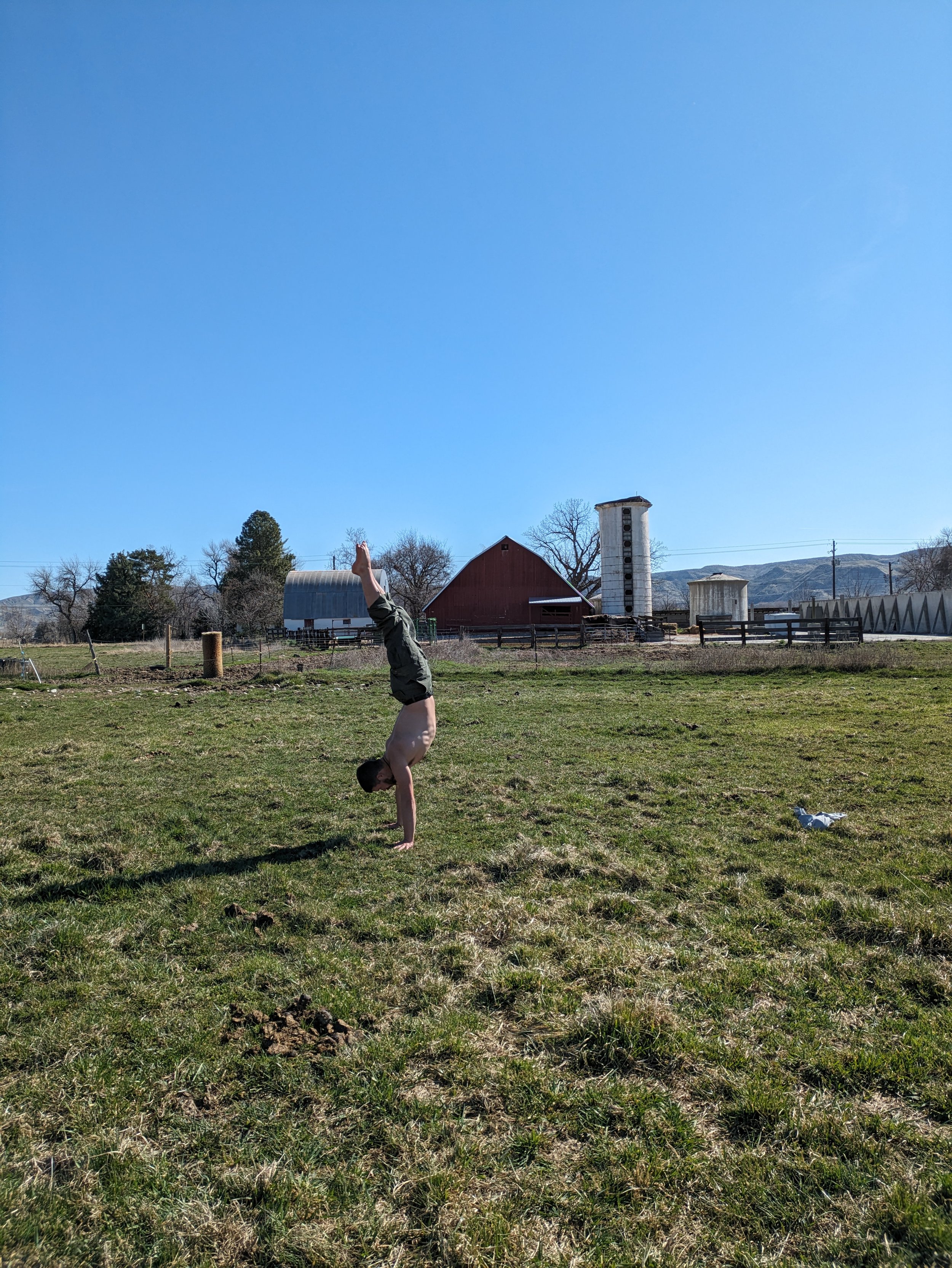
JJ doing handstands in the spring warmth.
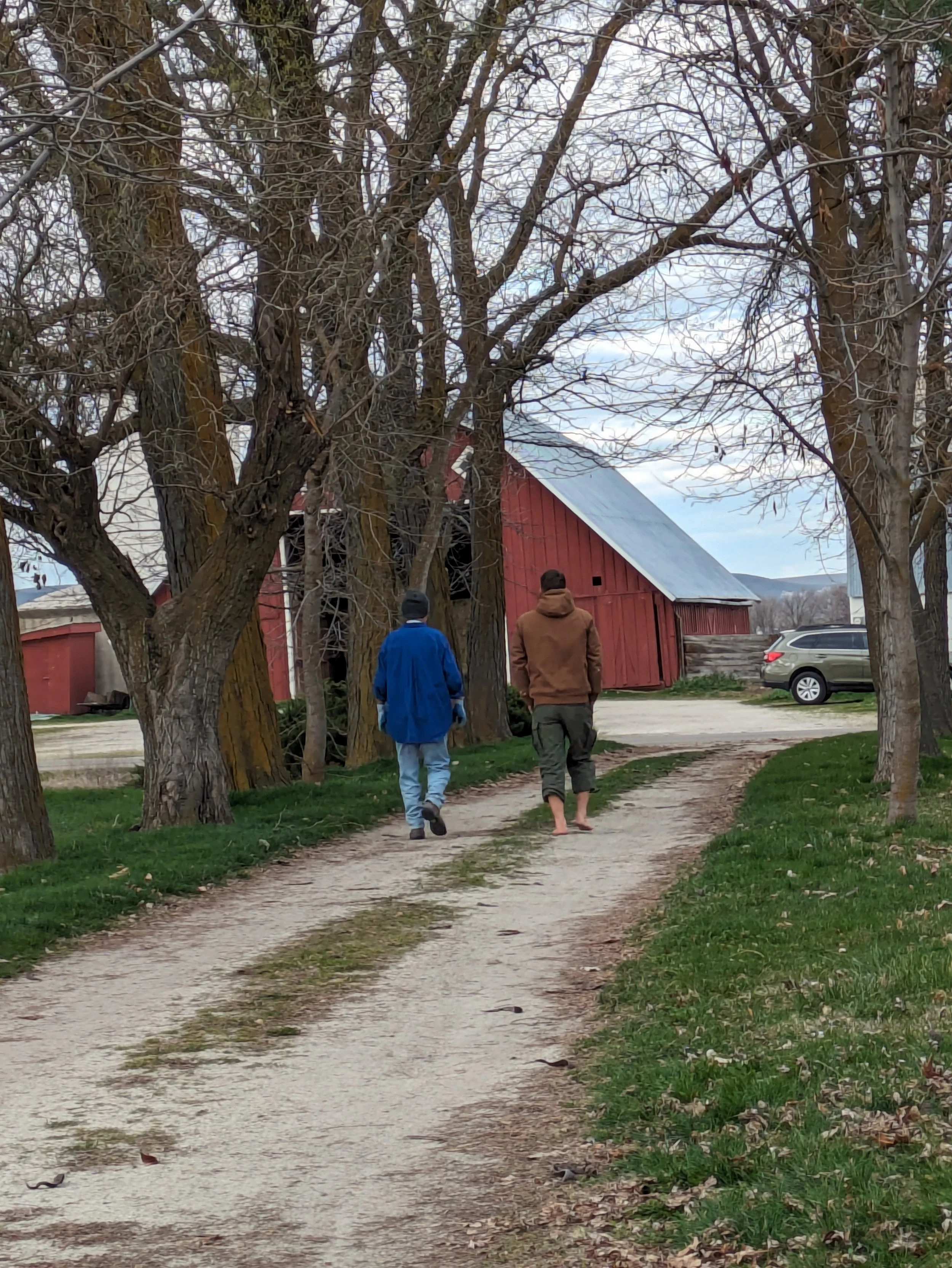
JJ and Dad going to get beef out of the big freezer... JJ in coat and hat and bare feet... :)
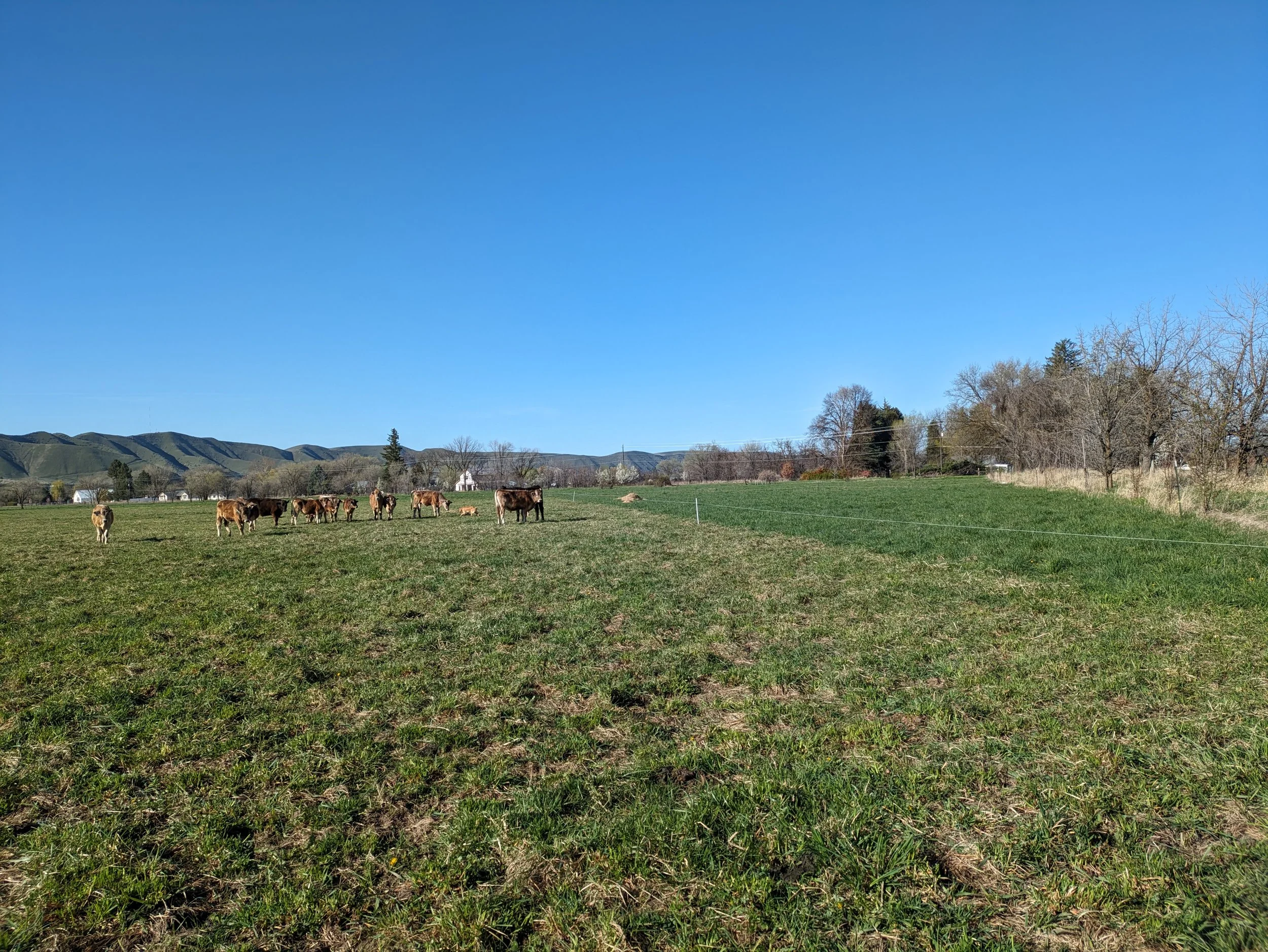
We use temporary fences in the paddocks to give the cows fresh grass every day. Here's the line of where they ate up to the fence, and I'm about to take the temporary fence out for this day's feeding.
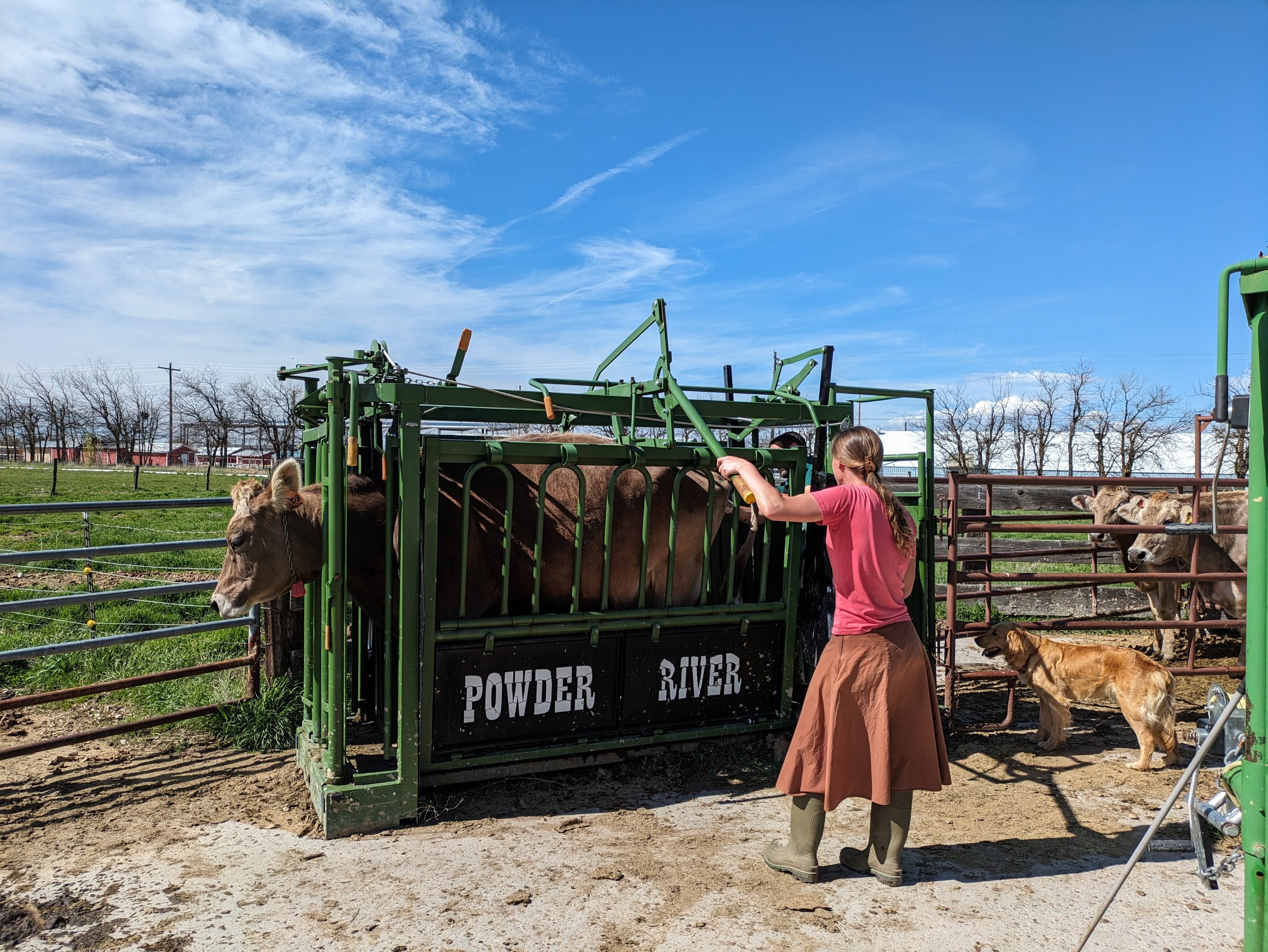
Dorothy and Lia helping me with Vet Peter.

Fueling the tractor with Sean.
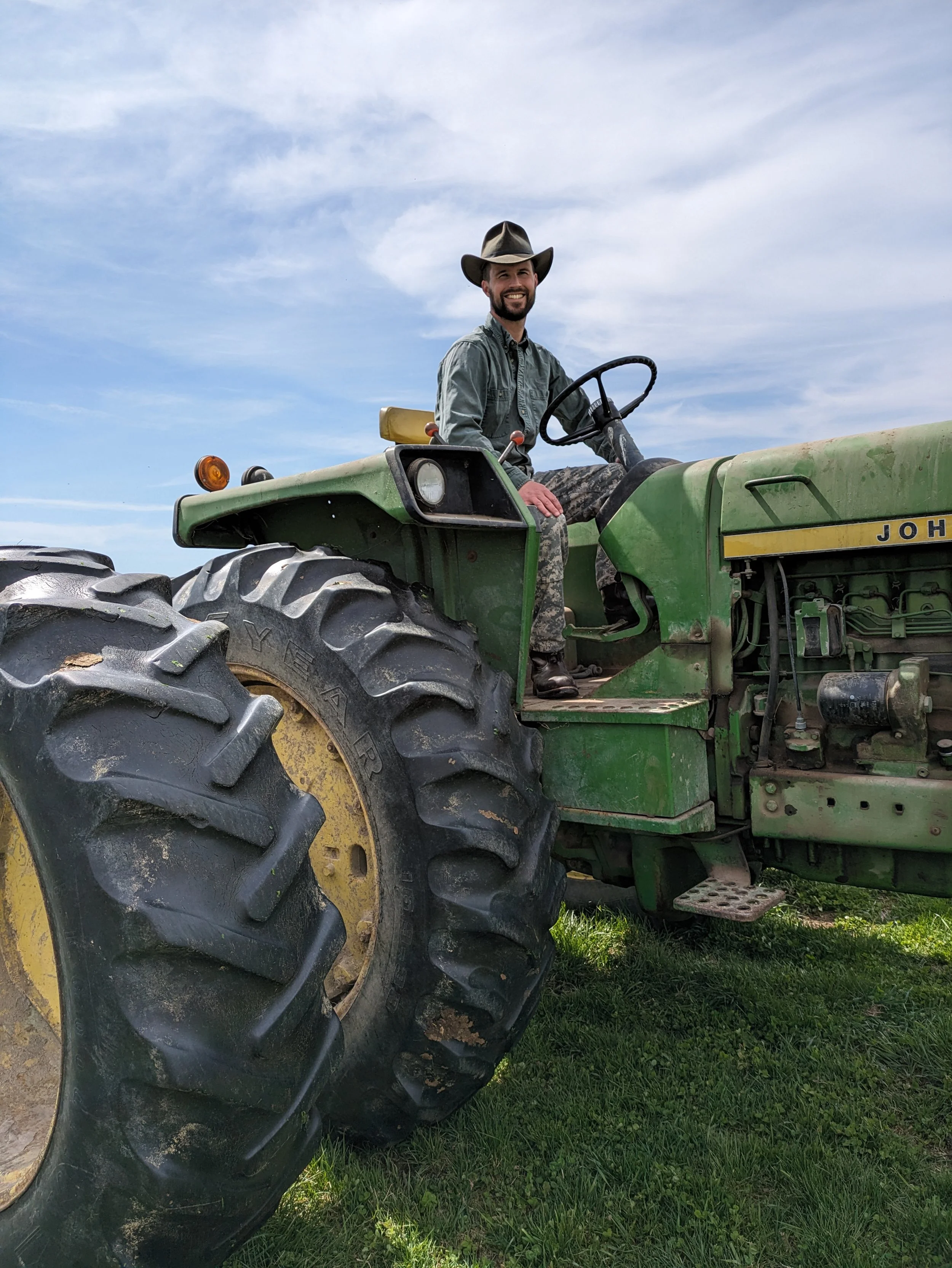
Aaron on the big tractor, heading out to harrow the fields.

Luthien kneeling to graze under the wire. It's really handy when the cows mow the fencelines for me, to keep the grass off of the wires!
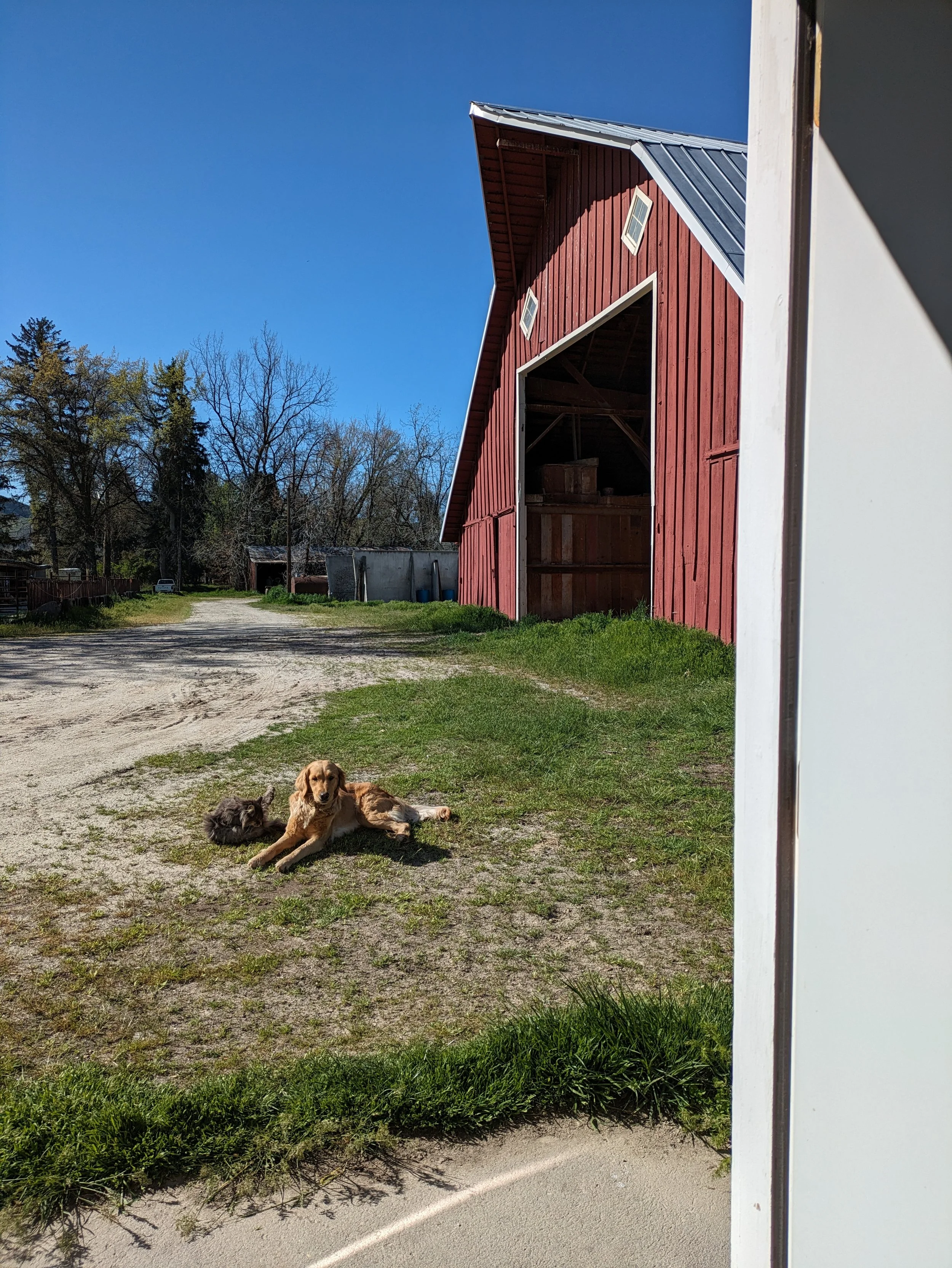
Lia and Blue waiting for me to finish in the milk barn.

Nap time for 6 months old Nick Saint, using Huckleberry as a pillow.

First baby of the year. Aciano from Clover.

Nala... One of our nicest milk cows.

Blue babysitting, and Lia very excited to play but trying to be calm and not bowl the baby over with her enthusiasm.
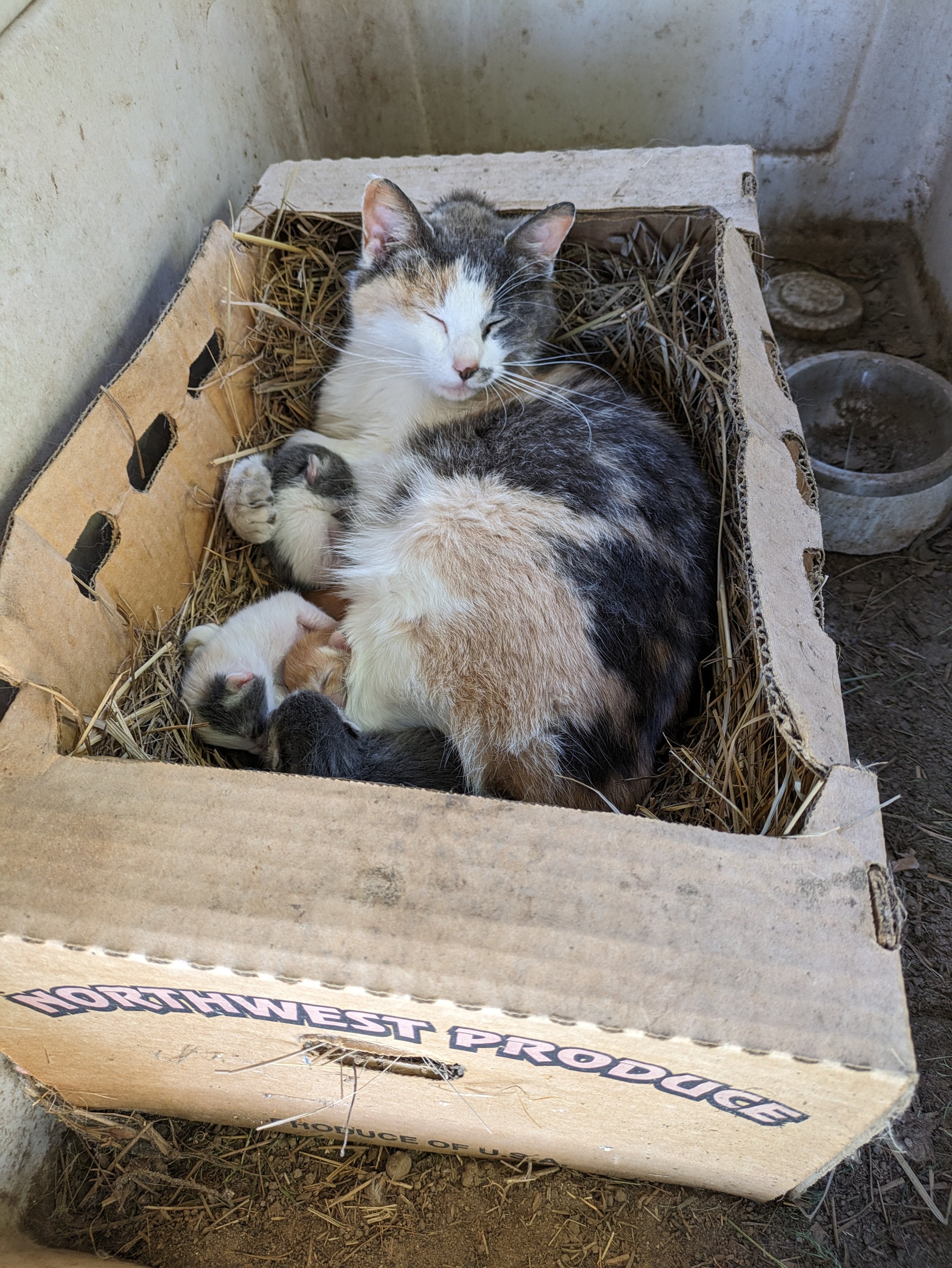
My Julie cat is very happy with four kittens.

Quince tree in bloom.